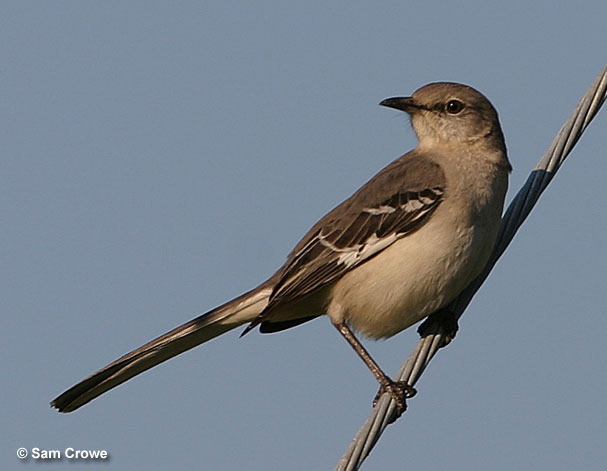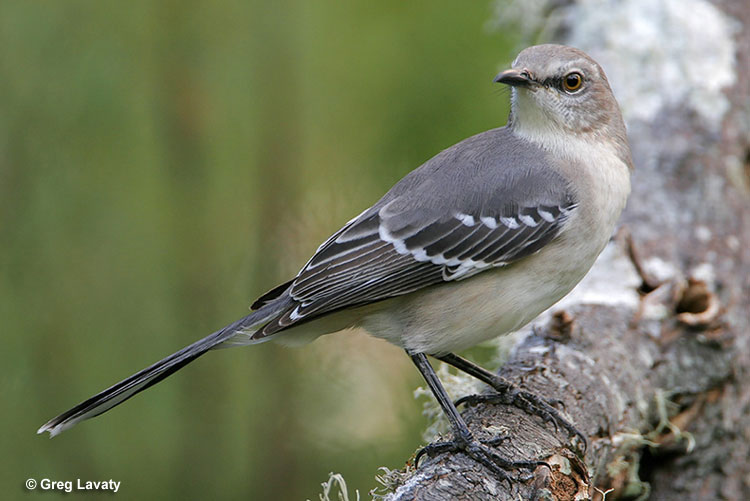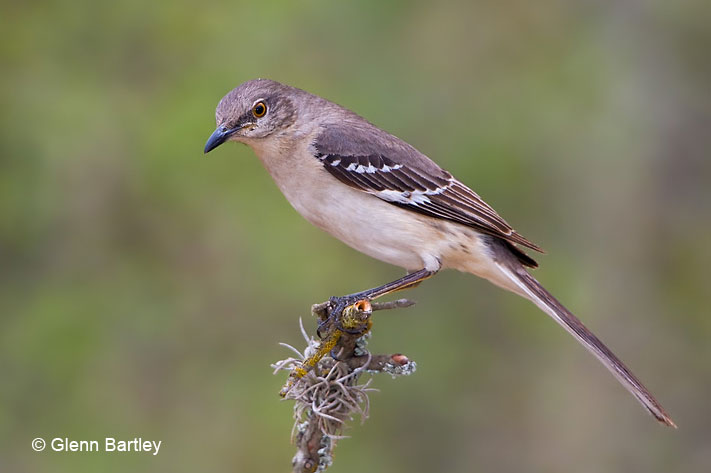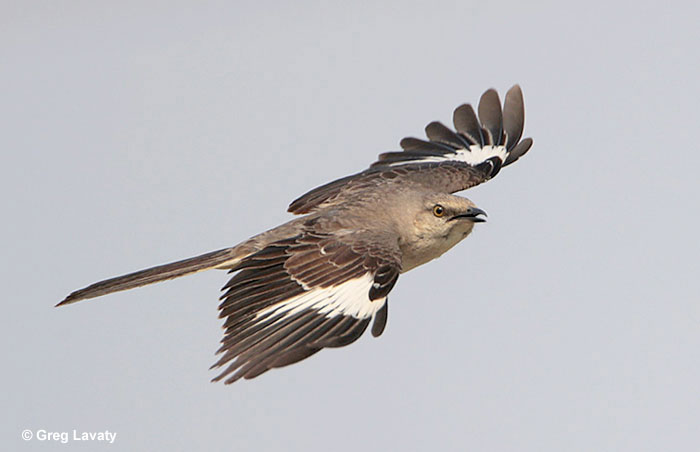
The Texas State bird is the Mockingbird – one of the most plentiful birds in North America. They can be found in every state in the United States year-round and in parts of Mexico, Canada, and the Caribbean.
Texas is a south-central U.S. state whose terrain consists of sand hills, canyons, desert valleys, islands, desert grasslands, and wooded mountain slopes. The capital of the state is Austin. It’s a large state with a population of over 30 million people and a 268,596 sq mile size.
Northern Mockingbirds visit backyards often. However, they don’t usually visit feeders. You can attract mockingbirds to your yard by keeping your lawn open while providing fruiting bushes or trees, including blackberry brambles, hawthorns, and mulberries.
On this page
History
The Northern Mockingbird (Mimus polyglottos) became a state bird of Texas in 1927.
This was an extremely popular nomination, and the Texas State legislature was all for this because they noted that the Northern Mockingbird is “found in all parts of the state, in winter and in summer, in the city and in the country, on the prairie and in the woods and hills, and is a fighter for the protection of his home, falling, if need be, in its defense, like any true Texan.”
Finally, in late January 1927, Governor Dan Moody approved this, and Texas became the first state ever to choose a state bird. Since then, Arkansas, Tennessee, Mississippi, and Florida have also adopted the Northern Mockingbird as their official state bird.

Northern Mockingbirds inhabit areas that have open ground and shrubby vegetation like thickets, fruiting bushes, and hedges. Common places to find Northern Mockingbirds include cultivated land, parkland, second-growth habitat at lower elevations, and suburban areas.
These birds are abundant and easy to spot throughout much of North America. They love to perch in high places with little to no coverage, like utility poles, lines, and tall shrubs. You may even see them running or hopping around your yard.
Facts about The Texas State Bird
- Mockingbirds almost vanished entirely from the east coast of the United States. This is because, in the 19th century, many people would keep mockingbirds in cages. People would trap adult Northern Mockingbirds and take nestlings out of nests. They would then sell the nestlings in major cities. Some of those cities include St. Louis, New York, and Philadelphia. In 1828, people could get as much as $50 per bird. For reference, that’s the equivalent of $1454.89 today.
- Northern Mockingbirds are excellent at mimicking and singing. As a result, these birds will continue accumulating new sounds and add them to their collection throughout their lives. For example, a male may learn around 200 songs throughout his entire life.
- Northern Mockingbirds usually sing in February to August. They’ll stop singing until September rolls around and sing again in early November. It’s been noted that male Northern Mockingbirds have a song for spring and another song for fall.
- Female Northern Mockingbirds sing too! It’s common for people to think that it’s just the males. However, the females are usually much quieter. Female Northern Mockingbirds almost never sing in the summer. They’ll sing more in the fall; it’s theorized that this establishes a winter territory.
- Northern Mockingbird’s scientific name is Mimus polyglottos, which roughly translates to many-languaged mimicker.
Identification
Northern Mockingbirds are grayish-brown overall, have two white wing bars on each wing, and are paler on the belly and breast. The white patches on the wings are usually the most visible when the birds are perched.
The patches become big white flashes when the Northern Mockingbirds are in flight. The outer tail feathers are also white and flash in flight.
Northern Mockingbirds are 8.3 to 10.2 inches (21 to 26 centimeters) long, weigh 1.6 to 2.0 ounces (45 to 58 grams), and have a wingspan of 12.2 to 13.8 inches (31 to 35 centimeters).

Female Northern Mockingbirds look identical to breeding male Northern Mockingbirds. They’re the same size and length and have the same wingspan as males.
Juvenile Northern Mockingbirds look very similar to adult Northern Mockingbirds. However, they have spotted breasts instead of white breasts.
Calls
Both female and male Northern Mockingbirds sing. These songbirds are excellent mimics and can produce sounds of frogs and other birds around them, including hawks, shrikes, orioles, blackbirds, jays, and killdeer, to name a few.
Mockingbirds will continue to learn and make new sounds throughout their whole lives. The song they make is long and a series of phrases. Each phrase repeats up to 6 times before they’ll move to a new sound.
Their songs can go for more than 20 seconds! Many of these birds’ phrases are whistled, but Mockingbirds can also make trills, scolds, and sharp rasps.
Northern Mockingbirds make a dry, harsh hew or chew sound when mobbing any predators invading their nests or chasing other Northern Mockingbirds.
Mates will exchange a quieter version of this call during nestling and incubation periods or when the female has to leave the nest during the incubation process.
Mockingbirds also make a sequence of up to 8 scratchy; short chat calls to scare off intruders. Female Mockingbirds produce one single chat when distressed.
What Do Northern Mockingbirds Eat?
Like many other birds, Northern Mockingbirds eat insects during the warmer months and switch to fruits and berries for winter.
During summer, most of their diet consists of grasshoppers, ants, beetles, crickets, and earthworms.
When it comes to fruit and berries, their diet consists of a wide variety, but some of their favorites are elderberries, juniper, and blackberries.
Behavior
Northern Mockingbirds are found either in pairs or alone throughout the entire year. These birds are easy to spot because they make themselves visible. These birds will sit and sing on top of poles, shrubs, utility lines, trees, and fences.

Additionally, they hop, run, and walk along the ground with their tails cocked upwards. They’ll grab prey off the ground or snatch them from just over the grass.
The Northern Mockingbird is aggressive to other birds, pets, and sometimes humans throughout the year.
Female birds will chase off other female mockingbirds, while males square up to male intruders. Males that dispute territory boundaries will fly toward each other, land near the territory boundary, and face off.
They quietly hop from one side to the other. Eventually, one bird will retreat, and the other will chase it a small distance. If neither bird retreats, they’ll fly at each other, grappling with claws and wings while pecking at each other.
Mockingbirds have been known to mob dogs, cats, and other animals.
Frequently Asked Questions About New York State Bird
What is the state bird of Texas?
The state bird of Texas is the Northern Mockingbird.
Why is the Mockingbird the state bird of Texas?
The Mockingbird is the state bird of Texas because it is a well-known and beloved bird in the state. Known for its exceptional singing ability and its adaptability, the Mockingbird represents the independent spirit and diverse natural beauty of Texas.
When did Texas choose its state bird?
Texas designated the Mockingbird as its state bird in 1927.
What other states have the Mockingbird as their state bird?
In addition to Texas, the Mockingbird is also the state bird of four other states: Arkansas, Florida, Mississippi, and Tennessee.
Discover more about Texas: Most common birds | Hawks | Owls | Ducks | Hummingbirds


David DeFalco
Sunday 9th of July 2023
You look SO nice! Pity you're not here in N Texas (though it's abysmally HOT right now!). Yeah, while we regularly see robins, blue jays and cardinals in our back yard, mocking birds are very frequent visitors (and welcome)!